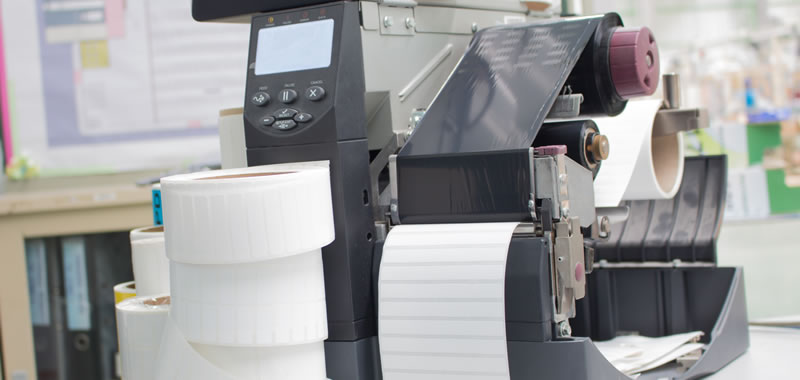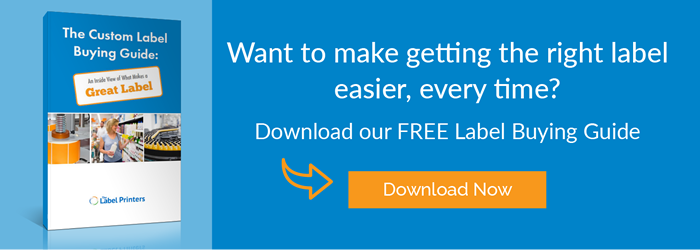
When you buy groceries, the question is “paper or plastic?” At a fast food counter you’ll hear, “For here or to go?” When you order custom labels, before your label printer can finalize your order, they’ll want to know, “Do you want those labels in rolls, sheets, or stacks of cut singles?”
It’s not simply a matter of preference. Each label format has its advantages, costs, and uses. And your label printer should be happy to walk you through your options and even make a recommendation, based on the way you plan to use your labels.
Keep in mind, there is no one “best” way to finish your labels after they have been printed. The important thing is to have a conversation with your label printer so you can choose the format that is best for your needs.
Rolls
What are they? Rolls are continuous strips of labels attached to a liner wound around a central core, like a roll of tape. Rolls are generally as wide as they need to be to hold one label across. Their diameter can vary according to the number of labels they contain and their intended use. The liner on rolls may be perforated to allow labels to be individually detached.
What are they best for? Rolls are often required for automatic label application equipment on production lines. If your product has a front and back label, you might need to order the fronts and backs on separate rolls. But, the technology for automatically applying front and back labels from the same roll — printed alternately — is increasingly common. To answer this question, you will need to know something about the equipment that will be used.
Rolls with perforations in the liner, between the labels, are a good choice because the perforations make it easy to tear off however many labels you need for one use and leave the rest on the roll.
Considerations: If you intend to apply your labels by hand, keep in mind that a big roll may be unwieldy to deal with while going about the process of applying your labels.
It might be more convenient to have your labels finished in smaller rolls, even if the extra work to do so means you might pay a little more. The convenience of easy handling will be more than made up for in avoided aggravation.
Label stock sometimes tends to stay curled when removed from the roll. Especially with larger – or long – labels, this can make them difficult to apply. In these situations, maybe rolled labels are not the right answer. That’s okay. We have other options for you!
Cut Singles
What are they? Cut singles are exactly what their name implies: labels cut individually. Cut singles may be attached to rectangular liners, the liner may be cut in the shape of the label but slightly larger to aid in separating them, or the liners may be cut to line up with the outline of the labels. In the case of the latter, there’s usually a slit in the liner to aid removal.
What are they best for? Cut singles are an attractive format if the labels are going to be sold or given out individually as stickers.
If your labels are going to be hand applied, especially by multiple people in multiple locations, cut singles may be the ideal format, as you can just hand out or send a stack to each person. If your labels are large, cut single format will keep them from curling – you can also request a split liner to make a smooth wrinkle-less and bubble-free application easier.
Considerations: Pressure sensitive labels finished as cut singles are not suited to automatic application systems. Generally, singles will cost more than the same labels finished in another format because they require additional tooling and labor compared to the other finishing formats. But, when singles are what you need, there really is no substitute for the convenience they offer.
Sheets
What are they? Sheets are similar to cut singles, except instead of being cut individually, each sheet contains multiple labels.
What are they best for? Sheets work well if you have to send your labels to several different locations. Sheets are also a good format for giveaway labels, for example, a sheet of stickers you might receive for visiting a museum.
Individual sheets can contain multiple labels of varying shape and size. For example, you might have a single sheet of holiday-themed labels that includes a tree shape, and ornament shape, and a snowman shape.
Considerations: Like cut singles, sheets are not made to be applied automatically. They do present a great option, though for situations where multiple designs and/or shapes are required and their flat format makes for easy handling and distribution.
Any Questions?
What label format is right for your brand? The best way to find out is to discuss the matter with an experienced custom label vendor. Over the years, we’ve helped thousands of customers make the best choices for their custom labels. We can help you, too. Contact us today.

